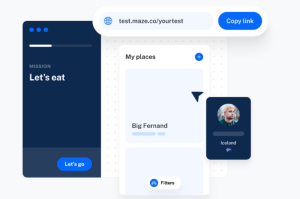A usability test allows you to spot issues or misunderstandings, as well as determine whether your product is easy to use and understand. It is essential to test your product or service before launch to ensure its success.
In the absence of spotting these issues, you might be offering your customers and users a product that doesn’t function properly, thus generating negative impressions and resulting in negative reviews, which will damage your business and product’s reputation.
Apart from finding issues, usability testing also allows you to discover many other important aspects of your product that you may not otherwise uncover.
Keep reading to learn more about them. This article will provide you with a list of the things usability testing can reveal and all its benefits.
Let’s get right to it.
What is usability testing, and what is its purpose?
Usability test involves getting real users to complete a list of tasks and observing their interaction with your product as they do so. A usability test is conducted to determine whether your product is easy to use, works correctly, and meets your users’ needs.
Therefore, usability testing will allow you to improve your product, generate new ideas, and comprehend its success potential.
This in-depth guide will let you better understand what it is more in detail.
When you need to conduct usability testing
The task of making users test a product is not something that you have to do only right before it is launched; there are different phases and situations in which you need to conduct usability tests.
Below you will find a list of some of the most important phases where testing is important.
1. Before launching a new product
Before making your product available to the public, you need to make sure it is functioning correctly and with no interruptions.
In fact, reputation is critical for products entering the market, and getting negative reviews at the beginning will contribute to ruining your business or product launch.
Because of this, it is imperative you gather insights from real people and have them test the product before launch and throughout the development process.
2. Before adding a new feature
Launching a new product is not the only time to conduct testing. You also need to consider this when adding a new feature, whether it pertains to functionality or appearance. Do users receive any additional value from this change? Is the new feature intuitive and simple to use? Is it free of bugs or other issues? Usability testing will give you all the answers you need.
3. After the launch of a product
Getting your product developed and tested is a continuous process that doesn’t end with the launch. You’d be wise to keep testing your product constantly and look for areas for improvement. The purpose is to ensure that you keep your products in a good working condition and that your clients are happy with them. Then, by considering the results of the product test, you can implement various post-launch strategies.
Usability testing: what it reveals
A usability test can help you learn a lot about both your product and your users. Knowing your users will enable you to develop new products and improve functionality to meet their needs and preferences. Also, you’ll know how to fix problems and improve the product so that it runs smoothly.
Listed below are some things you can learn from usability testing.
Effectiveness
What is the average time it takes for users to complete tasks? Are they completing them quickly or is the process slow? The speed of the process matters a lot. Nowadays users are more impatient than ever before, so if they can’t complete tasks effectively and quickly, they’re likely to get impatient about your product and be unsatisfied with it.
Learnability
Is it easy for users to learn and use your product? The ease of learning and using your product is another essential factor. A product that is hard to understand and learn to use will be unsuccessful. In contrast, if users are able to learn it quickly, then their level of satisfaction will increase much faster.
Inaccuracies
Approximately how many errors do real users make when using your product? A usability test can provide you with immediate answers to this question. You will be able to improve a product by recording and registering any mistakes, and by making it easier for people to use and learn.
Memorability
Does the customer have to re-learn the design after being away for a while, or do they remember it well enough to use it again? You can also determine this factor through usability testing; if a user is having difficulty remembering how to use your product or how to perform some actions, you need to make it easier for them.
Satisfaction
Once the testing process is completed, you can get feedback about how well the client enjoyed using the product. By reading the reviews, you can find out what aspects or features of your product you can improve and how to make it more user-friendly.
Benefits of conducting usability testing
Usability testing can help you uncover things about your products that you might not have noticed otherwise, resulting in many benefits. Below are some of the most relevant.
1. Uncover hidden problems
It’s possible that you are not aware of issues that can actually compromise the functionality or experience of your product when using it, whether it is a digital or physical product. In such a case, allowing others to test your product will allow you to identify any issues and fix them for a better user experience.
2. Assess the intuitiveness of your product
Perhaps you know exactly how to use your product, but how about users who have never used it before? How intuitive is it? Are users able to learn quickly where to click or how to use it? Through usability testing, you can gain insight into how users behave when using your product, helping you to improve it.
In the event it isn’t easy to use, it will likely be reported, and you will have an opportunity to make it more intuitive and easier to use.
3. Allows you to identify useless features and functionalities
Maybe you created a new product with some specific functions, or perhaps you added new features. How useful are these features, though? A usability test will provide you with valuable insight into how users view a feature or functionality’s usefulness.
If the feature is finding negative results, you can decide whether to remove it or edit it so that it is more valuable.
4. Analyze what needs to be improved
Testing users can provide you with invaluable information when they provide you with answers or reports. These can serve as ideas for how to improve your products. Perhaps they can provide a solution to a problem that you can implement in order to match their expectations.
5. Discover and implement new ideas
Conducting usability testing can also serve as a source of inspiration and where to get new ideas, such as those that relate to new products and features, as well as appearance and design. Then you can offer new perspectives and gain an edge over your competitors, allowing you to gain authority in your niche.
6. Get a better understanding of your users and their needs and preferences
By letting users try your product before you launch it or even after, you have an opportunity to gain a deeper understanding of customers’ expectations, needs, and preferences.
You can use this to create new features and products to increase user satisfaction and improve the overall user experience.
7. Recognize the possibility of your product’s success
Usability testing can also be helpful if you’re launching a new product on the market. It can tell you if users are satisfied with your product. By understanding how they feel about the design, features, and functionality of your product, you can figure out whether it has a chance of succeeding after launch.
Conclusion
In the development and launch of a product, usability testing is an essential step. You can discover issues and other aspects of your product and create opportunities for improvement.
Without this process, you may end up with an unsuccessful product that isn’t only unsatisfactory to your customers but will build an unfavorable reputation for you or your company.
Nevertheless, if you take into consideration when to conduct it and what you need to learn from it, as outlined in this blog post, you’ll be able to create a product that is widely appreciated by users.
Thank you for taking the time to read this article. I hope it was informative and helpful to you. For more information about this topic, please read this article on six best practices in concept testing for your new product.



